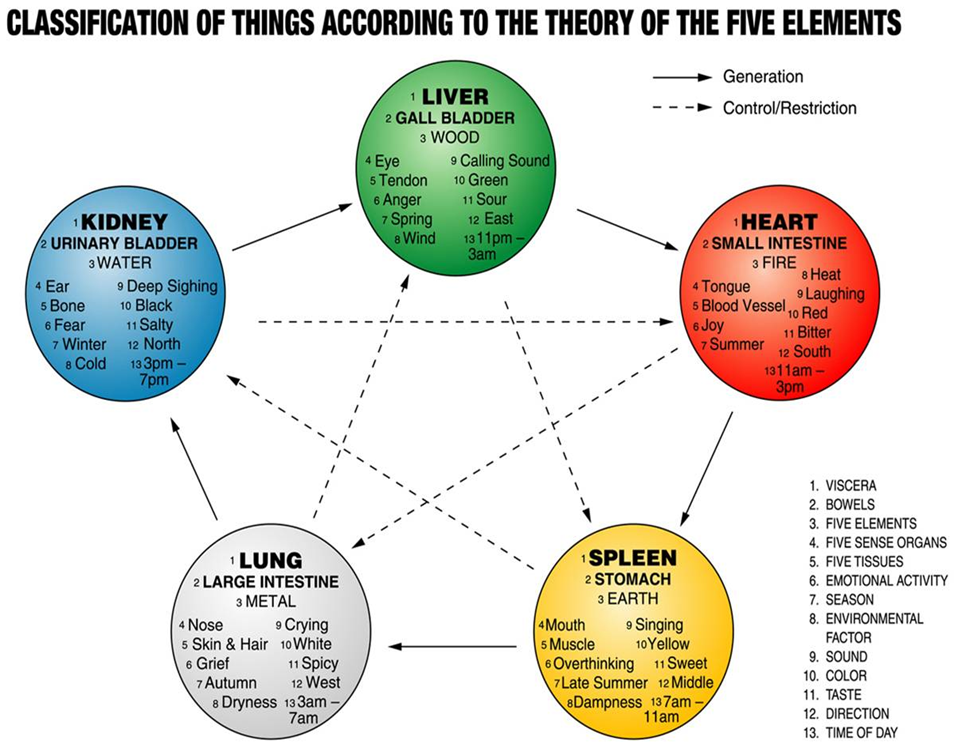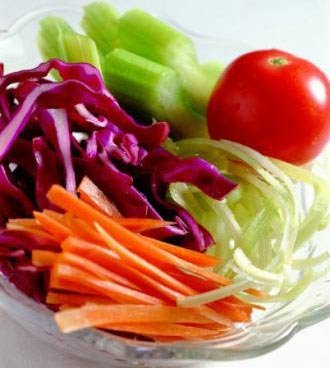By Ellasara Kling
Last issue we talked a little bit about the flavors of foods and some of the effects that those flavors have on the function of the various organ systems. Also based on Five Element Theory is the nature of foods which are categorized by essential temperature. This is not the temperature of the food as it comes from the oven or freezer, but rather the innate essence of the food itself. An easy to see example would be that a spicy hot chili does not become less spicy hot in the palate simply because it is frozen. The superficial coldness quickly gives way to the chili’s essential nature — spicy hot. The essential natures of food are categorized as cold, cool, neutral, warm and hot. It’s easy to know what some foods are, such as the chili, but others are a little more difficult. For example, the essence of a banana is cold. Beef is neutral in essential temperature, but deep frying it makes it hot.
This is a good place to digress for a few sentences and consider cooking methods and temperature. There are many different methods of cooking foods and each influences the nature of the food in different ways. The coldest method is no cooking at all. Eating raw food leaves it in its own essential nature but requires the body to use more energy to digest it and, depending on your own personal situation and how much raw food you are eating, can create other problems such as dampness. The manner in which food is cooked adds more or less heat to the food. Blanching, poaching, steaming, simmering, boiling and pickling are more cooling (yin) methods while stir frying, grilling, deep frying and roasting are common cooking methods that add more heat (yang).
Rather than create lists of cold to hot foods, I would like to offer some “rule of thumb” ways of recognizing a food’s innate temperature using Yin/Yang principles. Remember, Yin and Yang are rooted in each other. Their dynamic interaction is always seeking/creating balance. Consequently, separating them is only illustrative to demonstrate other ideas. Keep in mind that there are very few purely yin or yang foods so these are general guidelines.
Yin foods generate cold/cooler energy (grapefruit, chrysanthemum) and Yang foods warmer energies (cherry, spearmint). Neutral foods have a greater balance between the two such as rice and taro.
Yin foods are often soft, wet, can grow in little sunshine and can be salty whereas Yang foods are sweet, dry, spicy and grow under a hot sun.
 How does the Yin and Yang of food affect us? If for example, you have an internally hot situation you might find that you are constipated. Increasing your intake of cooler/wetter foods (such as spinach, green tea, broccoli) to bring greater balance to your system. A too cold condition can make a person feel weak, tired, logy. Eating warming foods can help lessen or remove these symptoms.
How does the Yin and Yang of food affect us? If for example, you have an internally hot situation you might find that you are constipated. Increasing your intake of cooler/wetter foods (such as spinach, green tea, broccoli) to bring greater balance to your system. A too cold condition can make a person feel weak, tired, logy. Eating warming foods can help lessen or remove these symptoms.
How can you use this basic information? First, it is always best to combine flavors and the essential nature of foods along with cooking methods to create meals that are balanced. A couple of simple ideas to get you started are: if you are eating fried food, have lemon-barley water (no ice please) with you meal or to eat some fruit such a cooling watermelon; when eating cold foods, balance your meal with some ginger tea; or add some spice to the other dishes.
People who eat vegan/vegetarian meals often have a cold condition making certain to include cooked root vegetables, dense squashes, nuts and seeds, and including spices such as ginger, turmeric, and cinnamon. In winter when the weather is cold, warming soups are a great way to go that will also make your stomach function very happy.
On the other hand great stress or very hot weather can cause an internal heat condition. Eating melon can assist in hot weather and green leafy vegetables, mung beans and pears are examples of cooling foods.
Ultimately following your intuition is always the best way to go. Pay attention to what your body tells you. Often, if you don’t know what it means, using Five Element Theory as a framework can provide a window to understand more deeply what your intuition is asking of you.
Wishing you good health! Remember to smile at all things.
Broccoli Rabe with Red Pepper & Walnuts
Ingredients
3-5 tb grapeseed oil 3-4 medium cloves garlic 3-4 slices fresh ginger (horizontal) =s about 1 TB 2 small red bird’s eye chilies 1 medium to large red pepper 2 lb broccoli rabe 1 cup toasted walnut pieces ¼ cup Shao Hsing Rice Wine (or dry sherry) ½ tsp Salt ½ lemon ½ cup cooked rice or rice cake noodles per person
Directions
Wash the broccoli rabe carefully and drain the excess water. Then carefully remove all the large, tough stems, including the tougher stems which may be attached to the florets, leaving the leaves, the florets and tender stem pieces.
Cut the leaves into wide (2”) horizontal ribbons, if possible. Set aside.
Cut the red pepper into large diced pieces.
Lightly crush the garlic, remove the papery skin, slice thinly lengthwise. Set aside with the sliced ginger and 2 chilies.
Heat your wok or large skillet and add the oil. Heat until the oil shimmers. Add the garlic, ginger and chilies. Stir fry for a minute to release the fragrance.
Add the broccoli rabe and toss in with the spices. Stir fry until it is about ¾ cooked. Add Shao Hsing wine and salt. By sprinkling them over the broccoli rabe. Toss well, but do not press the vegetable into the wok/skillet.
Add the red pepper and toss into the broccoli rabe. Stir fry until complete. (remove the chilis)
Plate over the rice or rice cake noodle. Squeeze the juice of the lemon over it and finally, top with the toasted walnut pieces.
The bitter flavor of the broccoli rabe is, according to TCM principles, a stimulant to the stomach. Looking above at the Five Element chart above, notice that the Heart energy (bitter flavor) generates the Stomach energy. So the bitter flavor is not only part of the essence of the Heart energy, but it also affects the Stomach in a positive way increasing its ability to produce, among other things, digestive fluids.
Kale & Kombucha Soup
Ingredients
2-3 TB grapeseed oil
1 large stalk celery – small dice
2 med. Carrots – small dice
2 cloves garlic, lightly crushed and sliced lengthwise
1 small bird’s eye chili
5 scallion whites – finely sliced in little rings
¼ tsp. Salt
3 qts cold water
¼ cup short grain sweet rice
1-1/2 lb Kale
1 lb Kombucha squash (butternut or acorn can also be used)
Directions
Prepare the Kale: Remove all the tough stems and cut the leaves into 1” horizontal ribbons.
Prepare the Kombucha: remove the seeds and cut lengthwise and then in to 1-1/2” tall triangles.
Set them aside.
Heat your 5 qt. soup pot add the oil. Heat until it shimmers. Add the garlic, celery, carrots, scallions, salt and chilies. Stirring a little Simmer for about 2 minutes or just until the ingredients are beginning to cook. Be careful not to burn or brown.
Add the water and short grain rice and bring to a boil. Reduce heat and bring to a low simmer.
Add the Kale and Kombucha . . Stir and check the level of liquid. Add some water if necessary. do not let it get too “dry”. And return to a simmer.
Simmer until the squash is tender – about 20 minutes or so. . the kale should be cooked. The rice will naturally thicken the soup. Make certain to keep it from being too thick. Remove from the heat and cover and let it sit for at least 20 minutes.
Here, we have Kale with its slightly bitter edge combined with sweet squash and sweet rice. In the two above recipes, please note that the flavors of all the elements are represented.
Simple Chicken Triple Mushroom Soup
Ingredients
1 large chicken leg w/ thigh
2 TB ginger
1 large clove garlic
1 piece of astragulas (huang qi/yellow vetch)
1 TB black vinegar
2 TB soy sauce
1 tsp sugar
¼ cup Shao Hsing rice wine (or dry sherry)
3 cups of carrot
10 pitted red dates
2/3 cup dried black fungus
2/3 cup dried shitake mushrooms
2 cups fresh portabella mushrooms
Toasted Sesame Oil
Cilantro – chopped 2 TB
Directions
Mushroom preparation: Soak the black fungus and shitake mushrooms in hot water for about ½ hour. Reserve the liquid. Remove the stems from the shitake mushrooms and slice both the mushrooms and fungus into thin strips. Set aside. Slice the portabella mushrooms into ¼” strips. If the strips are long, cut them in ½.
Remove any excess fat from the chicken and “hack” it in large pieces. Put it in a 5 qt soup pot with 4 qts of cold water
While the water is heating: Peel the ginger and julienne (shred) rather finely; slice the garlic lengthwise in several strips; and cut the carrots in ¼” inch thick slices
Add the ginger, garlic, astragulas, black vinegar, soy sauce, sugar, cooking wine, carrots, red dates and black fungus in the pot. Add the soaking liquid.
Bring to a boil, reduce the heat to a simmer and add the shitake mushrooms.
Simmer for ½ hour and add the portabella mushrooms.
Simmer for ½ hour.
In the meantime, chop 2 TB of cilantro leaves.
When the chicken is fully cooked, remove the chicken from the pot and strip the meat off the bone. Put the pieces of chicken in the serving bowls, ladle soup with mushrooms and red dates over the chicken. Remove the piece of astragalus from the pot as it tends to give too much of a bitter flavor when left in after cooking. Add a dash of toasted sesame oil and sprinkle cilantro on each bowl.
Because shitake mushrooms, black fungus, portabella mushrooms and astragalus are each purported to be immune boosters, this makes is an excellent warming winter soup that can bring you extra strength in this season.
Baked Spiced Apple Non-Pie
This recipe was inspired by an apple dish my friend Dianne sent me. I wonder though if she will recognize it!
Ingredients
1-1/2 lbs of apples – preferably organic*
Juice of ½ a lemon
1-1/2 cups toasted walnuts
8 pitted mejdool dates
½ cup pitted red dates
¼ cup goji berries
½ tsp ground cinnamon
¼ tsp ground star anise
1/8 tsp fresh ground nutmeg
½ to 1-1/2 cups organic apple juice
If using conventionally grown apples, definitely peel first. If organic apples, peeling optional
Directions
(Peel) and slice the apples as if for a pie. (Halve the apple, core, and cut in slices) sprinkle and toss with the lemon juice. Place them in a 9” deep dish pie dish.
Chop the walnuts, set aside. Chop the dates (red and brown) with the goji berries and mix in with the walnuts. Add the spices. And mix thoroughly.
Mix in with the apples. Pour ½ cup of apple juice over the apple mixture. Place in a 350 degree oven. Bake for about 20 minutes. Check the apples for moisture. If they are dry add some more apple juice. Back for another ½ hour – or more depending on how soft you want your apples to be. You can also “baste” the apples with the liquid produced from the baking.
This is an extremely “forgiving” recipe. More brown dates will make it sweeter. The spices can be adjusted according to your taste. Fruits can be adjusted also as it can be made with pears in the autumn. Although sugar/honey is not used here, it could be. Orange or grapefruit juice can be substituted for the lemon juice.
 [Following the threads of her personal tapestry, Ellasara, a long-time student of Master Nan Lu, weaves her life around the exploration and sharing of self-healing through a variety of modalities, primarily focusing on food, common herbal plants, Qigong Meridian Therapy and Qigong for Women’s Health. For comments, questions, consultations, ellasara00@gmail.com ]
[Following the threads of her personal tapestry, Ellasara, a long-time student of Master Nan Lu, weaves her life around the exploration and sharing of self-healing through a variety of modalities, primarily focusing on food, common herbal plants, Qigong Meridian Therapy and Qigong for Women’s Health. For comments, questions, consultations, ellasara00@gmail.com ]


